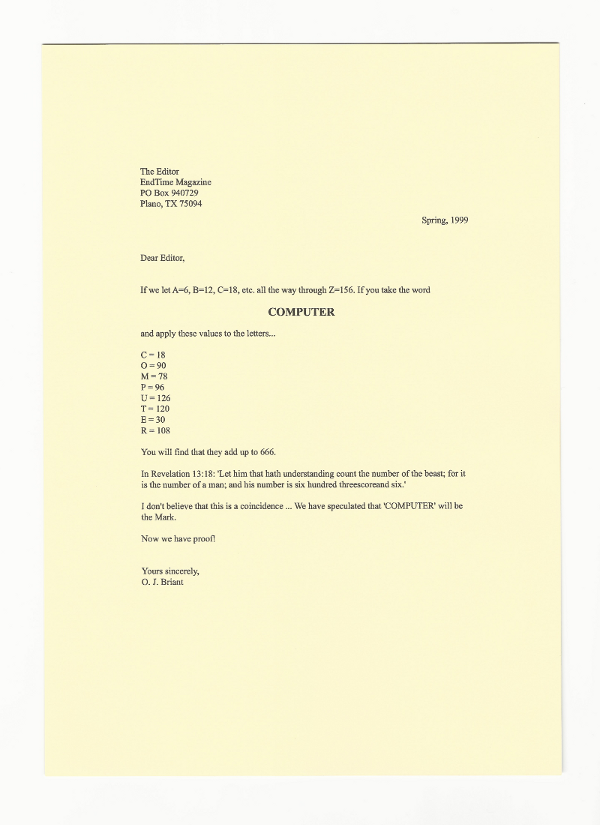Exe0.2 Linda Hilfling & Olle Essvik
END TIME : ENDLESS ENCYCLOPAEDIA - a complete index of all elements leading to the end of the world!
by Linda Hilfling Ritasdatter & Förlag Rojal (Olle Essvik and Joel Nordqvist)
This project draws upon Lindas research on the Y2K bug (see working article from exe 0.1 : [1]) The project is part of the exhibition "Bugs in the War Room" [2]
Project description
The generative bookproject End Time : Endless Encyclopaedia takes its starting point in crisis managment, cybernetics, and the belief in the objectivty of algorithms.
Towards the turn of the Millennium attention was directed towards the so called Y2K problem, or millennium or Y2K bug, as it was dubbed primarily in the Western world. Since the early days of computation it had been a routine to indicate year dates with two digits instead of four, leaving out the numbers specifying the millennium in order to save costly computer memory. But awareness of the implications of such practice suddenly arouse: When reaching the year 2000, the computer would not be able to distinguish the 00 of 2000 from the 00 of 1900. Thus it was assumed that “[u]nless reprogrammed, bypassed or replaced these systems will malfunction at the turn of the century, if not before, with wide ranging consequences” [Downing, 1998:i]. The Y2K bug was presumed to lead to failures within major financial institutions like banks or stock exchanges, payroll systems, telecommunications and power systems [Koskinen, 2000].
In spring 1999, when fears about the Y2K bug were at their highest, a reader of a Christian conservative magazine wrote a letter to the editor in which he carefully described how the computer, through a self invented numerologic algorithm, eventually could be proven to be the work of the devil. According to this system it was possible to translate the word "computer" to the values 666 – the number of Antichrist. Thus the letter writer satisfyingly concluded: "We have speculated that the computerchip will be the Mark, now we have proof!"
End Time : Endless Encyclopaedia is a reenactment of this letter to the editor and the numerologic system which it describes, however now translated into a generative computer code of one of the main programming languages which is said to have contributed to the Y2K millennium bug. The reenacted algorithm is continuously monitoring the Internet in order to detect potentially 'satanic' elements. Each time this occurs, a new letter is being generated and emailed to the editor of the journal End Time and at the same time a copy of this letter as well as a definition of it's term is being added as articles to the encyclopaedia. By the time of writing the executing algorithm has detected that besides "computer", even "Santa Claus", "Humanity", "New York", "Ipad Touch", "Kilowatt" and "Cherry Coke" among others all result in the number of the Beast and are thus to be proven to be works of Lucifer.
When the amount of articles reaches 666 they are compiled into a new volume of the endless encyclopaedia. Each volume is published and distributed as handbinded print on demand books by Förlag Rojal.
Tech specs in brief
- The heart of the project, the reenactment of the numerologic system described, which is able to prove if something is the work of Antichist or not, is written in COBOL: A third generation programming language which was one of the main programming languages contributing to the Y2K problem.
- Potential satanic elements are monitored through RSS-feeds, which are then being scrutinized by the COBOL program.
- Definitions are generated with python and COBOL.
- The encyclopaedia is being printed on bible paper 60g/m2
- The book lock is 3d printed.
- Handbinded and distributed by Förlag Rojal.
About Förlag Rojal
The publishing project Rojal förlag was founded in the spring of 2014 by the bookbinder/artist Olle Essvik and the translator/artist Joel Nordqvist – as a vehicle for binding, publishing, collaborations, discoveries and distribution of stories, ideas, objects and images – too narrow to be viable in larger editions, expired, forgotten or unfit for conventional formats.
References
Downing, Emma. “The Millennium Bug: research paper”. Science and Environment Section , House Of Commons Library, 1998.
Koskinen, John (2000)” What Happened to Y2K?: Koskinen Speaks Out”, White House Y2K Czar's summary of Y2K on 01/27/2000. Online: www.co-intelligence.org/y2k_KoskinenJan2000.html - visited November 20, 2015.
